Near the Spanish-French border lies the dazzling Basque Country, an autonomous community in northern Spain. This region has its own distinctive characteristics, culture, traditions and even language, and is best known for producing highly acclaimed wines and for its unique way of snacking (curious already?). Here we will show you what are the top 10 things to do in the Basque Country, a fascinating and captivating region!
Marvel at Bilbao’s architecture, visit the Guggenheim Museum and get to know the La Ribera Market
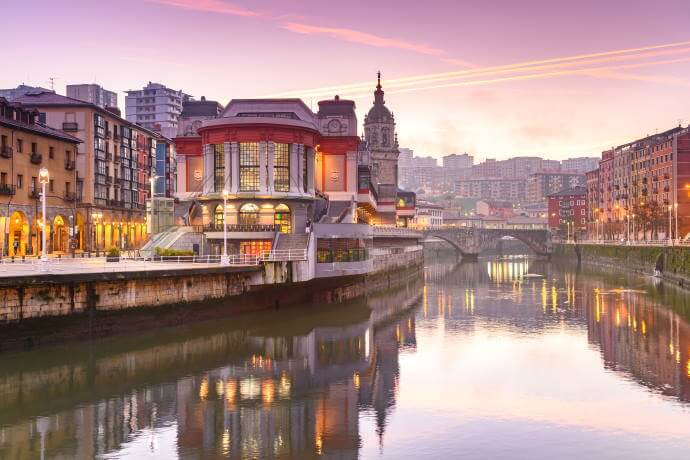
Bilbao is a world-famous cultural center and the largest city in the Basque Country. This distinctive city with an industrial past has now a new cultural dynamic – there are plenty of art galleries scattered along the revamped neighbourhoods, which also house some lively bars and original shops. But Bilbao is far more than its art scene: there are many picturesque buildings and a lot of charming traditional houses to admire in the old city center. One of the biggest highlights is undoubtedly the Guggenheim Museum, a titanium giant and a landmark of contemporary architecture, with a striking exterior. Its shape is remarkable! It was designed by Canadian architect Frank Gehry and inaugurated in 1997. At the entrance, you will also see the figure of the West Highland Terrier, known locally as Puppy, covered with plants and flowers. In the old town, on the banks of the Bilbao estuary, you will also come across with La Ribera market, the largest covered market in Europe, built in the Art Deco style. At this place, vendors sell various fresh products, such as meat, fish, seafood, fruits and vegetables. There is even a restaurant that uses these fresh local products in its menu. As you can see, there are plenty of reasons why Bilbao is a great destination and a must-visit in the Basque Country!
Step into an epic adventure at San Juan de Gaztelugatxe
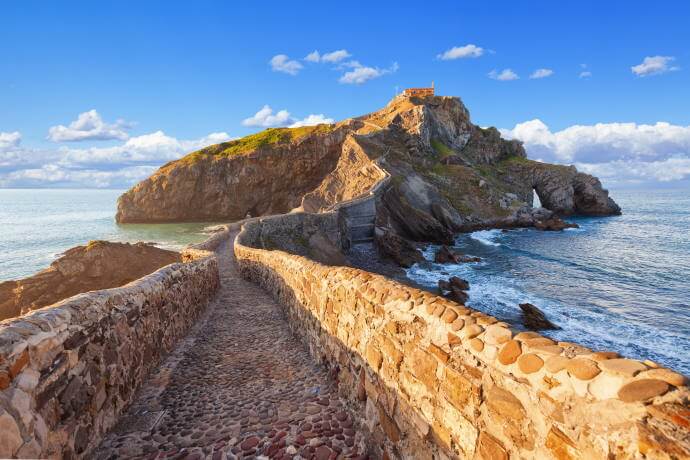
The name of this small, cone-shaped islet, which was once a defensive post, means “castle rock” in the Basque language. It is connected to the mainland by a narrow stone bridge, which can only be reached on foot. At the highest point on the islet, you will find a small hermitage and a church that dates back to the 9th century. To get to this church, after passing the stone bridge, you will have to zigzag up a scenic path with 241 steps - but the spectacular view makes up for the effort! Legend has it that when visitors arrive, they should ring the bell in front of the church three times and make a wish. In truth, this small islet looks straight out from a movie set or a fairy-tale, so it's no surprise that it served as a filming location in season 7 of the famous Game of Thrones series. San Juan de Gaztelugatxe is a unique, mystical place, and a visit there is definitely a special experience! Enjoy the magnificent views of the sea and the surrounding nature.
Try the pintxos in San Sebastian and admire the panoramic views in the picture-perfect Bay of Concha
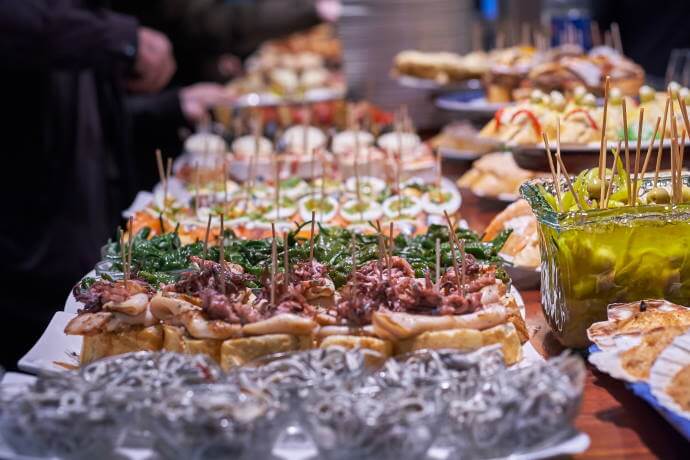
There is nothing quite like wandering through the streets in the old town of San Sebastian and sampling the famous pintxos – a kind of tapas, but smaller - in one of the many bars or taverns. In fact, the perfect way to do so is to go from bar to bar to taste the different specialties and to experience the distinct atmospheres. You can try, for example, the classic Gilda pintxo, which consists of an olive, an anchovy and a spicy guindilla pepper. However, there are many other types of pintxos to try, such as the tortilla (omelet filled with soft potatoes and caramelized onions), the jamón Ibérico (Iberian ham), or the brocheta de gambas (prawn brochette). San Sebastian, which has achieved great notoriety, is considered to be one of the major culinary capitals in the world and a true gastronomic Mecca. Michelin-starred restaurants are abundant as well - San Sebastian is a gourmet's paradise! For you to completely make the most of your visit, a stop by the Bay of Concha is also a must. This iconic crescent-shaped bay, whose promenade offers fantastic views, stretches for about a kilometer and a half alongside the city. The urban beach has white sand and translucent waters, it’s equipped and surrounded by nature. Even for just a simple stroll, it is well-worth the visit.
Admire the colourful houses in Hondarribia
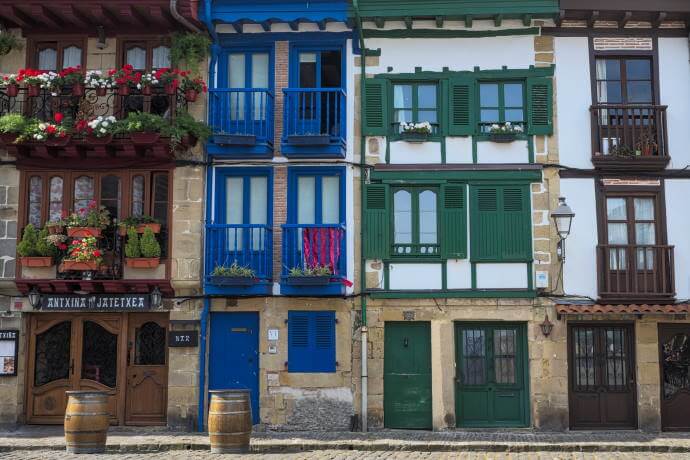
This ancient fishing town, located on the border between France and Spain, is sure to catch your attention with its colorful houses, renowned restaurants and maritime atmosphere. Perched on the mouth of the Bidasoa River, Hondarribia has a well-preserved walled historic center (Casco Antiguo), characterized by typical Basque houses, lovely squares and colorful wooden balconies. A stroll through the traditional old town with its cobblestone streets and vibrant mix of bright colors is undoubtedly a special experience. The neighborhood of La Marina, next to the old port, was home to many fishermen for centuries - it is the town’s most picturesque neighborhood, full of eye-catching facades and balconies decorated with flower pots. This coastal jewel of incomparable beauty perfectly combines the sea with the mountains, creating an amazing backdrop worth exploring. And let us remember the tasty cuisine and delicious wines you can taste here - a glass before lunch is always welcome!
Head to the beach in Zumaia and marvel at the rock formations
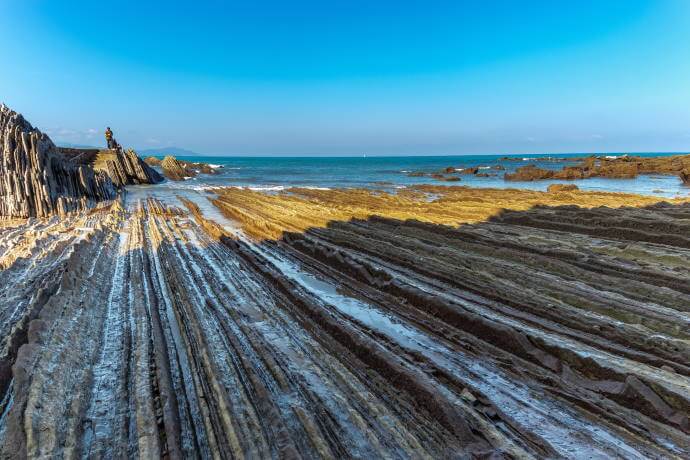
Located in a charming bay, west of San Sebastian, where the Urola and Narrondo rivers meet, you will find the small seaside town of Zumaia, mainly known for its amazing rock formations. Its two beaches, Itzurun and Santiago, are located among the longest set of continuous rock strata in the world, which is a true geological treasure. Known as “flysch”, this natural phenomenon dates back to the mid-Cretaceous period and is an interesting sight, especially for geologists. Although this is definitely the main attraction, there are other reasons that make Zumaia a great stopping point, such as the charming Basque Gothic-style church of San Pedro, the narrow, steep streets full of restaurants that make up the old town, or the house museum of the painter Ignacio Zuloaga, where you can find beautiful works by El Greco, Rivera, Zurbarán and Goya. It is worth exploring the stunning coastline, where the green of the slopes blends harmoniously with the vivid blue of the sea.
Taste the Txakoli wine
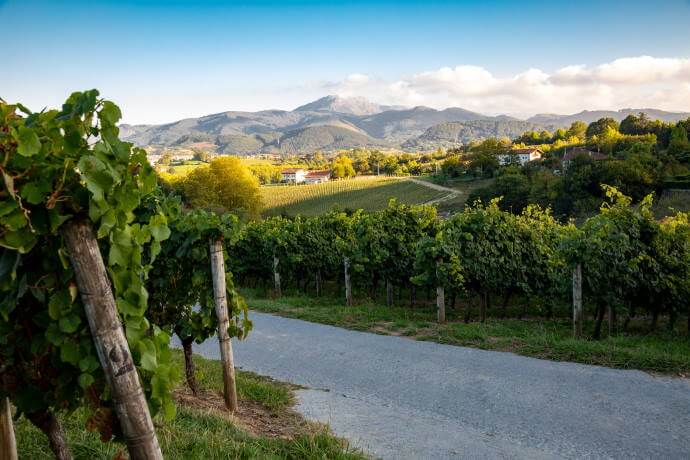
First of all, what is the Txakoli wine like? Very well-known in this region and a common appetizer, the Txakoli is a fruity, light, slightly sparkling, fresh and dry white wine, with high acidity and low alcohol. It is a refined wine, typical of the region, made mainly from a local grape called Hondarrabi Zuri. This region has the ideal climate for growing the grapes from which this famous wine is made. Some say that the best and right way to try this unique wine is with some pintxos on the side! In the Basque Country, there is even a unique way to serve this drink: Tradition dictates that the wine must be served at a certain distance from the glass, in the air, and in tall glasses. Throughout the region there are several wineries where you can taste the wine and learn more about the production process. It is certainly a must-do when visiting the Basque Country!
Go to Vitoria-Gastéiz, visit a World Heritage Site and explore the cobbled streets
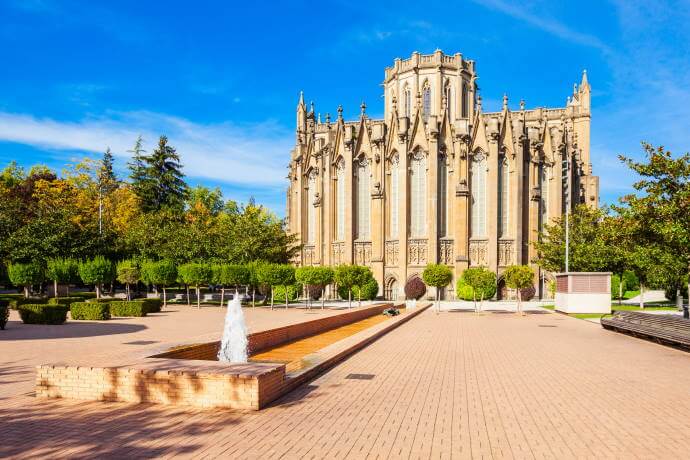
Sometimes overlooked, the city of Vitoria-Gastéiz has its own charm, character and life. With a very rich heritage, it is home to a World Heritage Site – the Santa María Katedrala (Cathedral of Santa María de Vitoria). Located on top of the hill, this cathedral is also known as Catedral Vieja or Old Cathedral. It was completed in the 14th century in Gothic style and stands out for its majesty and its bright blue bell tower. Divided into three parts, the cathedral has undergone intensive remodelling over the past few years. Around this cathedral you will find the oldest streets of the city. When you are in the Basque Country, be sure to stop by Vitoria-Gastéiz and admire the imposing facade of this religious building, as well as the 11th century walls that surround the medieval part of the city and the numerous beautiful buildings from the Renaissance period. Since Vitoria-Gastéiz is surrounded by a green belt consisting of large parks, you can also enjoy the fresh air and lush vegetation. If you are into art, there are also various museums to explore and artistic creations in the form of graffiti throughout the center to marvel at.
Make a detour and explore the La Rioja-Navarra region and the bodegas
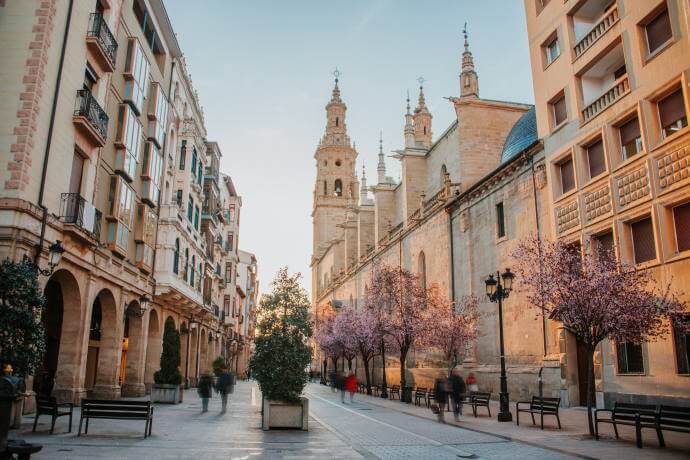
The region of La Rioja is best known for its world-renowned wines and hundreds of wineries. Visiting the bodegas scattered throughout the region is an excellent day program, especially for wine lovers. You can learn about the winemaking process, get to know the brands and taste the wines. And you must also take a moment to admire the vast vineyards, and breathe in the fresh air that the surrounding nature offers. There are several towns worth visiting, such as Logroño, the capital and a compact and labyrinthine city with plenty of pintxo bars and interesting sights; Laguardia, a small medieval-style fortified town, where you can visit cellars and underground tunnels; Pamplona, with its narrow streets, cobbled squares and Neoclassical buildings; or Olite, with an impressive castle and picturesque honey-colored stone houses. Many of these towns are even crossing points for pilgrims walking the Way of St. James, a reason why they also have religious significance. In this region, you will find interesting wine museums and, of course, emblematic wineries, but also an important cultural heritage and monuments worth exploring and visiting, such as the beautiful cathedral of Pamplona, the Royal Palace of Olite or the churches of Logroño.
Do a road trip through the coastline and explore the Mundaka beaches
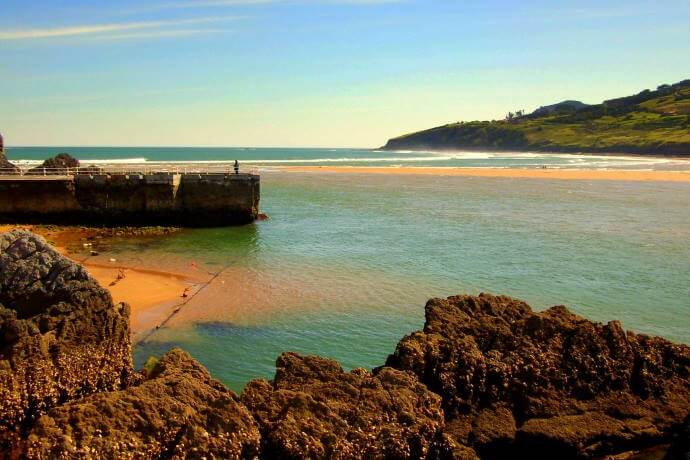
Mundaka is a coastal town, located at the beginning of the Oka River’s estuary, and is well-known among surfers for its big waves. Other than water sports, this town is a great place for a walk by the sea, near the port. You can take a road trip along the coast or leave your car and explore this coastal region on foot - either way, Mundaka's beaches are real gems to discover. Admire the fishermen's cottages that have retained their medieval character, or stroll through the narrow streets of the historic center. By the sea, you will find Mundaka beach, Playa de Laidatxu, an urban beach with golden sand and a favorite among surfers. There are many other beaches to discover, such as the wilder Playa de Laida on the other bank of the Urdaibai River, part of the Laida Biosphere. If you want to marvel at the incredible views, you can always head to the Mirador de Atalaya, a lookout point on the right side of the harbor that is the perfect place to watch the waves break at the mouth of the river.
Discover the Urdaibai Biosphere Reserve
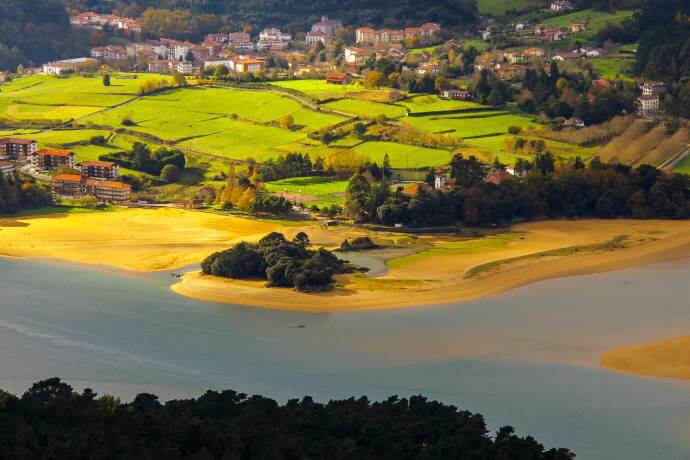
Between the capes of Matxitxaco and Ogoño, there is a 12-kilometer stretch that is a true biological treasure - the Urdaibai Biosphere Reserve. This natural scenery of great beauty and diversity is a piece of paradise, for the animals that live there but also for its visitors. The most important wetland in the Basque Country, located near Mundaka and classified as a reserve due to its importance and conservation by UNESCO, is a great place for birdwatching enthusiasts, as it is home to some quite rare bird species. The large marshland and coastal landscape with high cliffs and capes are worth admiring, especially since Urdaibai also has an important cultural, architectural and archaeological heritage for the Basque people, such as Katillotxu and the Roman settlement of Forua. The reserve includes green cliffs, beaches, rivers, marshes, numerous ecosystems and riverside meadows, as well as the islands of Txatxarramendi and Izaro. Gernika, famous for the painting by Pablo Picasso inspired by the bombing of the city in 1937 when much of it was destroyed, is also in the area. When in Guernica, be sure to pass by the Tree of Guernica, which stands in the heart of the site of the Assembly House of Bizkaia. Under this tree, in the 14th century, the Lords of Bizkaia established the regional customary law that gave autonomy to the Basque Country. It became a symbol of the history of Bizkaia and Basque society since then!



